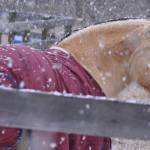Winter Care of Horses: Blankets and Body Condition

Outfitting horses in winter can be an exercise in perseverance and patience, but blanketed horses stay warmer and conserve more energy than their naked peers. Thermoregulation is an energy-expensive proposition for horses. As temperatures plummet, how does blanketing affect hay consumption and body condition changes?
A group of researchers set out to determine the daily hay intake, body weight change, and body condition score changes in blanketed and nonblanketed horses living in western Wisconsin.*
Researchers used 16 mature horses of various breeds in the study; eight wore blankets, and the remaining eight went without blankets. Horses were not blanketed until the temperature fell below 5° C (41° F). The average body condition score of the horses at the onset of the study was 5.5, moderate to moderately fleshy.
Horses were stabled in drylots with shelters and were given free-choice access to grass-legume hay as round bales. The bales were weighed before feeding, wrapped in mesh netting with 4.45-cm holes, and placed in ring-style round-bale feeders to limit waste. Leftover hay in the feeder was weighed. Intake was estimated as the difference between hay provided minus hay leftover during the trial period divided by the total body weight of the drylot.
The study was divided into three periods based on consumption of each round bale.
- First period: December 29-January 6—average temperature: -2.7° C (27° F)
- Second period: January 7-January 12—average temperature: -8.5° C (17° F)
- Third period: January 12-January 21—average temperature: -12° C (10° F)
Temperature throughout the study varied from a high of 5° C (41° F) to a low of -23° C (-9° F).
Regarding hay consumption, the blanketed horses ate an average of 2.3% of body weight per day, while unblanketed horses ate an average of 2.5% of body weight per day. For a 1,050-lb (476 kg) blanketed horse, for example, this would amount to 24 lb (11 kg) of hay per day, and for an unblanketed horse 26 lb (12 kg) per day, a difference of nearly 2 lb (0.9 kg).
These results, according to the researchers, suggest blanketed horses conserve energy, leading to decreased hay intake. While blanketed horses had a slight weight gain by the end of the study (7.3 kg or 16 lb), no difference in body condition was noted between the groups, and body condition did not change from the beginning of the study for either group.
Healthy horses have an incredible tolerance for cold weather, especially if they are accustomed to the climate or have earned easy-keeper status, but others may be more susceptible to the chill of colder seasons. How can you tell when horses require the additional warmth offered by a blanket?
- If a horse does not have access to shelter (stall, run-in shed, three-sided building, etc.), which would protect it from rain, sleet, and wet snow, a blanket may be appropriate, as horses are better able to fend off cold if they are dry.
- If a horse shivers, a blanket and additional forage might be appropriate measures to protect the horse from cold. Extra forage will keep fermentation of the hindgut active, which will, in turn, boost internal heat production.
- If a horse is entering the frigid season in suboptimal body condition, a blanket might be appropriate. Caution is warranted, however, as blankets may rub bony anatomical features, such as the points of shoulder, withers, and points of hip.
- Senior horses and fine-skinned horses may also have a harder time maintaining body condition as cold descends, and a blanket may be part of management strategies for them.
- Horses that have been body-clipped will most certainly need protection, as may horses that have a predisposition to stubborn skin disease such as rainrot that regresses with exposure to moisture.
- Blanketing requires a certain measure of devotion, as careful attention must be given to the fit of the blanket throughout the season as well as its necessity each day based on the weather.
Some horses can maintain their body weight on all-forage diets during the winter months, especially when granted free-choice access. “While forage should be the foundation of all diets, no forage contains a complete quota of the vitamins and minerals needed for optimal health,” said Catherine Whitehouse, M.S., a nutrition advisor at Kentucky Equine Research. “Horses should be offered a balancer pellet or a vitamin and mineral supplement formulated by a reputable manufacturer.”
Other horses will require a fortified concentrate in addition to good-quality forage to maintain body condition through the winter, explained Whitehouse.
*DeBoer, M., A. Konop, B. Fisher, and K. Martinson. Dry matter intake, body weight, and body condition score of blanketed and nonblanketed horses in the upper Midwest. Journal of Equine Veterinary Science 94:103239.








